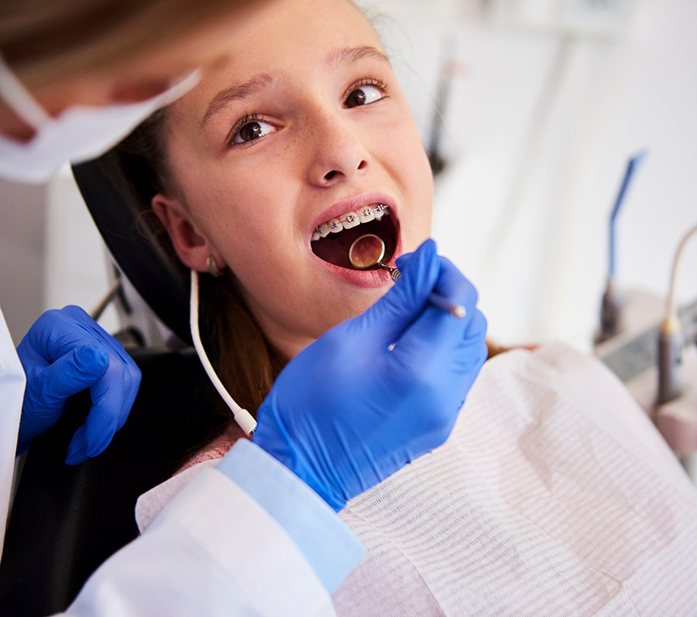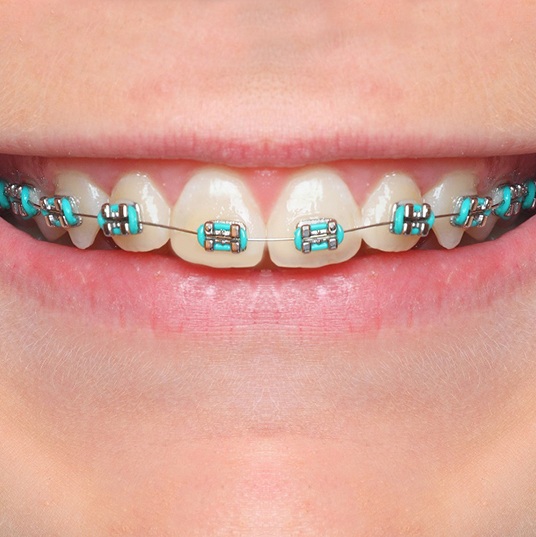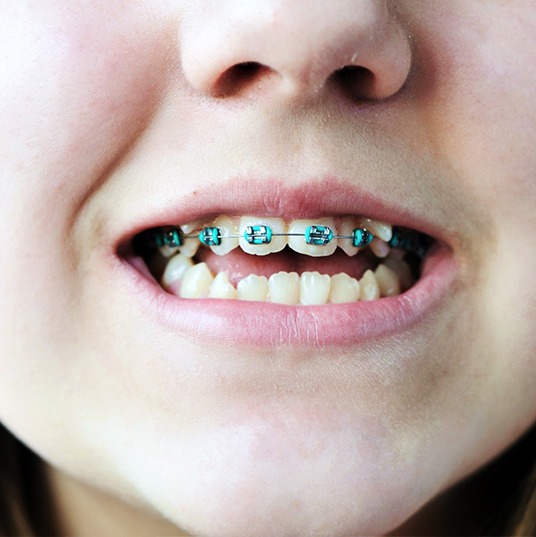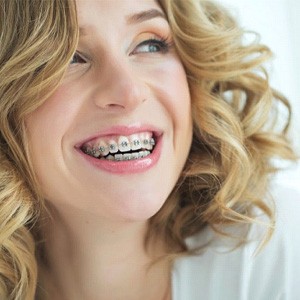Traditional Braces – Flower Mound, TX
Straighter Smiles Through Brackets & Wires

Even today, traditional braces are the most popular way to straighten teeth. That’s only natural – this treatment has aligned grins effectively for decades! At this point, many people think of it as one of the rites of childhood. Naturally, then, you can trust the braces from Dr. Rogers at KidSmiles Dental and Orthodontics. They’ll ensure your children get straight pearly whites in little time. To learn more about them, continue reading or book a consultation.
How Do Traditional Braces Work?

As you might already know, teeth shift if left alone. Their connection to tiny jaw ligaments allows them to move over time. Consequently, they can turn crooked and unfit to the point that they lower your quality of life.
Fortunately, traditional braces can reverse and prevent this outcome. They rely on brackets and wires that put pressure on crooked teeth. In doing so, they gradually push pearly whites into a straighter, more aligned position.
Generally, a braces treatment lasts a year or two. This timeline lets the dentist adjust the archwire every 6-8 weeks. That way, the appliance remains functional and fixes smiles until the very end.
What Orthodontic Issues Can Braces Fix?

Before your child gets braces, they’ll attend a consultation with Dr. Rogers. This visit helps her assess the relevant orthodontic issues, oral health, etc. Based on her findings, she can determine if braces suit the kid’s needs.
As part of the consultation, Dr. Rogers will see if your little one has problems that braces solve. These include the following:
Bite Misalignment
Bite misalignment may seem trivial, but it can lead to severe problems. Left unchecked, it tends to cause TMJ dysfunction and bruxism (i.e., teeth grinding).
Thankfully, braces can easily fix this dilemma. Proper ones slowly move a patient’s jaw muscles into alignment. As a result, the bite is made nice and even.
Crowded & Crooked Teeth
Crooked and crowded teeth don’t just look bad; they harm oral health. For example, they erode tooth enamel due to rubbing each other excessively. Similarly, their crookedness leads to tooth sensitivity and a higher risk of cavities and infections.
Of course, metal braces can address this situation. They gently guide a smile so its teeth don’t overlap or rub one another.
Gapped Teeth
Gapped teeth are a cosmetic problem and a health-related one. After all, the spaces between them look unpleasant and house germs that damage mouth tissues.
All that said, braces can (and do) correct tooth gaps. Aligning a smile with brackets and wires closes up the spaces between teeth.
Caring for Your Braces

For better or worse, braces need regular maintenance to work. Your child thus needs to clean and care for them daily. To help them do so, try using the following tips:
- Practice Good Dental Hygiene – Make sure your child brushes twice daily for a full two minutes. At the same time, ensure they floss at least once a day. (They can use flossers if necessary.)
- Avoid Risky Foods – If your youngster bites into hard, crunchy, or chewy foods, they might break the archwire or dislodge the brackets.
- See the Orthodontist Often – It’s crucial that your kiddie attend orthodontic adjustment visits. As they do so, our team will assess their braces to ensure treatment is going well.
Understanding the Cost of Traditional Braces

Traditional braces are an effective and versatile way to straighten out a misaligned smile. While this treatment delivers significant benefits for a patient’s health and appearance, it’s important to know what kind of financial commitment is involved. During your orthodontic consultation, our team will evaluate your teeth and jaw to develop a personalized plan to realign your bite. We’ll be sure to explain the entire planned timeline of your treatment as well as how much you can expect to pay. Read on to learn more about paying for braces in Flower Mound.
Factors That Affect the Cost of Traditional Braces

Each orthodontic treatment is different, and the overall cost is influenced by factors like:
- Severity of alignment issues: More complicated cases take more time to treat.
- How long the treatment lasts: Wearing braces for a longer time usually means needing more checkups, adjustments, and supplies, raising the overall cost of treatment.
- The patient’s age: The teeth of adults are more firmly set than those of children who are still developing. It takes more time to shift adults’ teeth, so their treatments generally cost more.
- Needed follow-up appointments: Braces require adjustments every two to eight weeks. Needing more of these appointments can raise the overall cost.
- Required materials: Many patients will need to wear appliances like space maintainers, palatal expanders, and headgear. These all add to the price tag.
- Treatment compliance: Failing to precisely follow your orthodontist’s instructions can lead to delays in treatment that add to the cost.
Professional Braces Vs. “DIY” Braces: Which Costs More?

Some people try to straighten their teeth with household items like fishing lines, superglue, and paper clips, but these cheaper methods can cause injuries that are expensive to treat. A few of the risks of DIY orthodontics include:
- DIY methods cannot reliably deliver long-lasting results. Without an orthodontist’s guidance, your teeth are likely to shift back out of place after treatment.
- Amateur braces can injure teeth, gums, and jawbone, increasing the risk of infection. Some people lose teeth because of DIY orthodontics.
- Realigning a smile without orthodontic supervision can create new bite issues or even cause jaw pain or a TMJ disorder.
- You can spend more repairing the damage caused by DIY braces than you would have by getting professional treatment in the first place, and you’ll probably still need to wear braces anyway.
Receiving your orthodontic treatment from a professional can prevent all these issues, sparing you from more expensive treatments later on.
Does Dental Insurance Cover Braces?

While not all dental insurance plans cover orthodontic treatment, those that do usually pay for traditional braces rather than clear aligners. Braces are more likely to be covered if they address medical issues like a misaligned jaw than if they address aesthetic issues. However, many plans cover braces for patients under eighteen years of age.
If your plan pays for braces, you can usually expect up to 50% coverage. While the specifics depend entirely on your particular plan, our team will be more than happy to help you figure out the details. You may be able to use a Health Savings Account or a Flexible Spending Account to partially pay for your treatment.
Options for Making Braces Affordable

Our office offers several ways to help make orthodontic treatments easier on the wallet. These include:
- Low-interest financing for uninsured families.
- Yearly savings plans that give a child two preventive visits, one emergency exam, a 15% discount on all dental services, and one free orthodontic exam with 15% off orthodontic services. These plans are available for $395 a year for children three and up. Please call our office for pricing for children under the age of three.
We are always happy to help patients understand how they can pay for orthodontic treatments. Feel free to contact us to learn more about how to get started.
Traditional Braces FAQs
Am I Too Old to Get Braces?
There is no upper age limit for traditional braces. In fact, even though our practice is called “KidSmiles,” the truth is that we welcome orthodontic patients of virtually all ages, including mature adults! Whether you are in your 30s, 40s, 50s, or older, it may be possible for us to help you achieve improved oral health through the power of orthodontic care.
For the most part, treatment is the same for younger and older patients. However, your age might mean that your teeth move a bit more slowly than those of younger people. Your overall costs might also be higher. Our team can walk you through the details of your treatment when you attend a consultation.
How Long Do Traditional Braces Take?
The timeline for traditional braces varies greatly from patient to patient, but on average, it takes 18 – 36 months to complete treatment. During your consultation, we may be able to provide a more precise estimate for your unique case.
Some details that might affect your treatment timeline include:
- The severity of your dental misalignment. Logically, more severe and complex cases take longer to address.
- Your age. The teeth of adults tend to move more slowly than those of children.
- Compliance with treatment guidelines. Failure to care properly for your teeth while you have braces could delay your final results.
Do Traditional Braces Hurt?
Some soreness and discomfort are to be expected with traditional braces. As the brackets and wires apply pressure to your teeth, you may find that your mouth aches. The metal parts of your braces could also cause mild irritation.
You can minimize your discomfort by rinsing with warm salt water, eating soft foods (especially when your braces get adjusted), and taking mild pain relivers. Sipping on cold water may also be helpful. Additionally, you can use orthodontic wax to cover any portions of your braces that bother the soft tissues in your mouth.
If you experience severe pain, call our office so we can help you handle the situation.
Can Traditional Braces Fix TMJ?
In some cases, temporomandibular joint disorder (TMD, also known as TMJ), can be caused by misalignment of the teeth and jaws. This condition can lead to significant pain and discomfort.
Often, braces can correct the misalignment that is causing TMD, producing long-term relief. However, orthodontic care is not a “one size fits all” way to fix TMD. During your consultation, we can offer an opinion on whether braces are appropriate in your unique situation.



